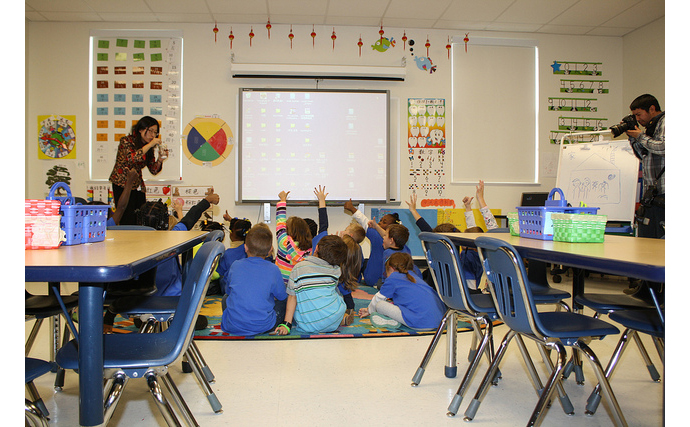
Late last year I wrote about how the Upper West Side rezoning plan intended to desegregate a handful of elementary schools could end up resegregating them in a new way through the addition of a Gifted & Talented program to PS 191, currently serving over 70% Black, Hispanic, and Free Lunch students. Bringing in a G&T program starting in the 3rd grade by using a screening method proven to discriminate against minority applicants is an obvious attempt to attract an affluent demographic to the traditionally low-performing school. Now, Principal Lauren Keville is floating the idea of a Dual Language Mandarin program, one of less than a dozen such public elementary programs.
But this strategy, one celebrated by Chancellor Carmen Fariña, will only exacerbate NYC’s failure to serve a large demographic — English Language Learners who benefit most from full inclusion in English-only classrooms.
Fariña is a huge proponent of Dual Language programs. She is constantly adding new ones, despite the city admitting they are having a hard time finding adequate, dual language-certified teachers for programs they already have, especially Mandarin. (Some schools have even forced students to switch languages mid-year.) This is disturbing, as teacher quality has been proven to be the main influence on student achievement. It’s arduous enough to find an excellent teacher. What are the odds of finding an excellent teacher who is also equally fluent in English and the second language?
In promoting her expansion, Fariña stated, “as a former English Language Learner [ELL], I know that a strong education makes all the difference, and these new bilingual programs will give students the foundation to succeed in the classroom and beyond.”
Her comment suggests that ELLs are intended to be the main beneficiaries of these programs. But is that the case? In many top-performing public schools, the Dual Language programs are filled with native English speakers whose parents are looking to give them another advantage. Mandarin is definitely the hot ticket, although an administrator at a school which offers both Spanish and Mandarin told me, “white parents want Mandarin, while Asian parents point out it’s only spoken in a few places, places where everyone also does business in English. They want Spanish. They think Spanish is the true global language!”
At another school with a Dual Language Spanish program, a Kindergarten class didn’t have a single native Spanish speaker. All those parents wanted their kids learning English!
Alternately, due to the lack of Gifted & Talented seats, savvy parents are opting for Dual Language programs as a way to make the standard curriculum more challenging in schools they would never attend otherwise.
One parent boasted to me, “We’re really the G&T, here.”
So where do the ELLs that Chancellor Fariña touted as having the most to gain from Dual Language programs fit into her strategy?
NYC is proudly publicizing a recent study that observed, “approximately half of the students who entered kindergarten in New York City public schools as English learner students were reclassified within four years.”
Forgive me for not joining the celebration.
Four years? (And that’s only half the students, which means some presumably took longer.) Four whole years?
I immigrated to the United States with my family in January of 1977, when I was 7 years old. The only English words I knew were “the” (because I couldn’t figure out what it meant) and “apple” (which was on the first page of my alphabet book).
By June of 1977, when my brother was born, I was standing in front of my second-grade class, telling them all about it – in fluent English. I distinctly remember saying, “He looks like a little pink pig.”
How did this happen in less than six months?
I was put in an English-only classroom. I had no choice but to learn English. So I did.
Bilingual education is an awesome, terrific, fantastic thing — for children who are already proficient in the language of the country where they live. The one where they will need to graduate school and take standardized tests and get a job. Fluency in a second language adds to their advantages in all of those things, and Dual Language programs are, unquestionably, a boon to this demographic.
But not, I’m afraid, to those whom they were ostensibly supposed to help the most. They are being left even further behind.
— Alina Adams
Alina Adams is a New York City mom of 3 school-age children. Her website is NYC School Secrets. This post originally appeared on New York School Talk.


